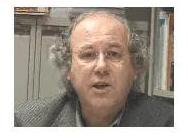= = compact version = =
The human body
(the cardiovascular system)

Your instructor (Rik) |
The monitor. |

Your patient (Maurice) and his doctor (YOU) |

Your instructor (Rik) |
The monitor. |

Your patient (Maurice) and his doctor (YOU) |
Dit prototype van het cardiovasculaire systeem van een gezonde proefpersoon, Maurice, genereert feedback, d.w.z. video-messages. Als deze gesimuleerde persoon onverhoopt een hartzwakte krijgt, van rond bijvoorbeeld HSB = 0.5, genereert hij ten behoeve van de user op vrij willekeurige verschillende momenten dit soort video-messages. Elke video-message heeft een eigen, vaak complexe conditie (c1, c2 tot c8), d.w.z. de voorwaarden waarop een message true kan zijn en het video-filmpje gestart wordt. Er zijn al messages true bij o.a. CO < 4800.0 [ml/min] bij ECFV > 18000.0 [ml]. Probeer maar eens.
The simulation time is in minutes ('Tijd'). You have five days ('5 dagen') to work with this subject. The red 'growing' graph is the (mean) arterial blood pressure (AP) (in mmHg); the green graph is the heart rate (HR); the yellow graph is the urine output (UO); the blue one the cardiac output (CO), the amount of blood through the heart in one minute.
Remark that MAURICE can say somethings if you do the wrong thing or nothing. A video-window is (than) coming up. If you do the just thing (the just therapy) (and you give the good medicine and also the best amount of them) than you see the most variables go back to normal.
I call this kind of feedback 'intelligent feedback'. These feedback will be generated by a model-driven rule base.
Other remarks about the model-interventions at the left: 'Nierfunctie' is the dutch word for 'renal mass' (RM). 'Hartfunctie' is the dutch word for 'basic heart strength' (HSB). 'Drinken' is the dutch word for 'water intake' (WIN) and 'digitalis' is the dutch word for the medicine 'cardiac glycosides' or 'digitalis' (DIGI).
This simulation and instruction environment is realized with the JavaTHESIS-system, version 3.9x (1999) of Rik Min (designer), Jacob Sikken (first version) and Jan de Goeijen (latest versions).
Enschede, 2002; updated 2003, 2004 and 2012